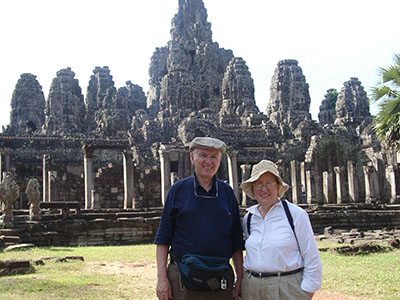 Angkor Wat, Cambodia
Angkor Wat, Cambodia Kyoto, Japan
Kyoto, Japan Iguassu Falls, Brazil
Iguassu Falls, Brazil Guilin, China
Guilin, China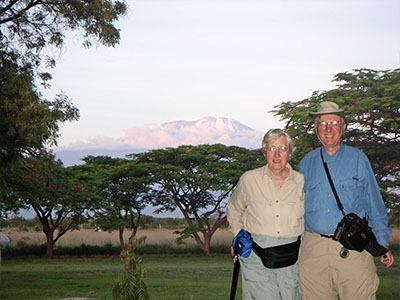 Mt. Kilimanjaro Tanzania
Mt. Kilimanjaro Tanzania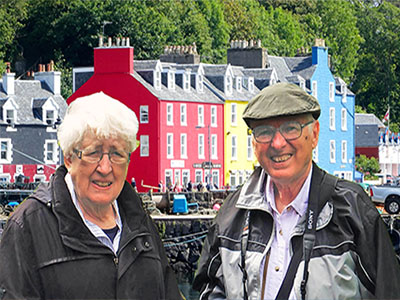 Isle of Mull, Scotland
Isle of Mull, Scotland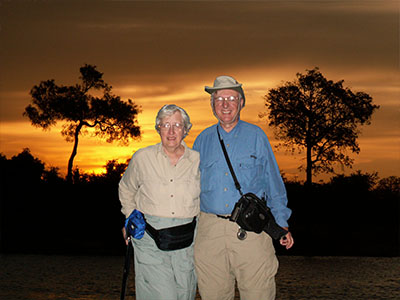 Victoria Falls NP, Zambia
Victoria Falls NP, Zambia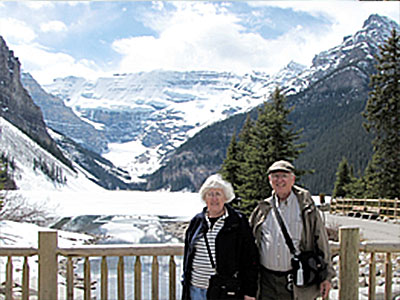 Lake Louise, Canada
Lake Louise, Canada Angkor Wat, Cambodia Angkor Wat, Cambodia |
 Kyoto, Japan Kyoto, Japan |
 Iguassu Falls, Brazil Iguassu Falls, Brazil |
 Guilin, China Guilin, China |
|---|---|---|---|
 Mt. Kilimanjaro Tanzania
Mt. Kilimanjaro Tanzania |
 Isle of Mull, Scotland Isle of Mull, Scotland |
 Victoria Falls NP, Zambia Victoria Falls NP, Zambia |
 Lake Louise, Canada Lake Louise, Canada |
Tricks of Experienced Travelers
We started travel immediately after we got married and moved from Oregon to Pennsylvania. We both worked full time, so we always spent our vacation time traveling. We not only toured the East Coast, we eventually visited all 50 states and all provinces of Canada. We started foreign travel 5 years later when we took a chartered flight to Amsterdam and picked up a European Delivery Volvo which was later shipped back to Pennsylvania for us. We drove our Volvo through 13 countries (Sweden, Denmark, Holland, Belgium, Luxembourg, West Germany, Switzerland, Liechtenstein, Austria, France, Italy, Vatican City, and England) in 3 weeks. Now we have traveled to over 95 countries not including 4 countries that don’t exist today (East Germany, Czechoslovakia, Yugoslavia, and the USSR). Not only have we spent every vacation day traveling, we took a sabbatical where we traveled continuously for 75 days. Since we retired, we have gone to some of the more exotic places we hadn’t visited before (Russia, the Black Sea, Easter Island, Israel, Turkey, Africa, and Antarctica) and we have gone back to some of our favorite places we had already visited (New Zealand, Japan, China, Galapagos, Norway, Iceland, and Scotland). Since we have been traveling for over 50 years, people often ask us for advice. Here is how we prepare for a trip and handle things we aren’t prepared for.
Mode: Car; Bus; Train; River Boats; Small Ships; Cruise Ships; Planes; Independent Travel Some of the options are the mode of travel and whether it is independent or group travel.
Car: One of the best ways to travel usually is by personal car or rental car. Driving is relatively easy in countries that have the same alphabet that we do. It is even easier with a GPS. Many European car makers have a European Delivery program where you buy the car before you leave home, and pick it up in Europe, drive it, and then the car maker ships the car home. You usually save quite a bit on the car, and get the use of it in Europe. We have done this 7 times with Volvo and highly recommend the program. When traveling by car, it is usually best to book reservations in advance at places that have parking available. Some older cities were not designed for car traffic. Cars are not a good option in large cities or for very long distances. Some cities such as London and Melbourne have restricted areas called Congestion Zones near the city center where cars are not allowed without special permits. Cars are also not useful in areas where roads are quite primitive. Bus: Bus tours are the least expensive, but also most restrictive. People are always taking photos out the window because the bus doesn’t stop. Window reflections and motion tend to make such photography very challenging. Tauck Travel has taken some of the unpleasantness out of bus tours by not filling the bus and rotating seat assignments so everyone gets to sit in the front and also we get to meet everyone on the bus as their seat assignment becomes opposite ours. Also, there is no rush to get back on the bus to get a good seat and no saving seats, practices that tend to get tedious on longer trips. Tauck also stops at the best hotels, so it is not cheap, but it is a good value.
Train: Train travel is very common outside the US. It is very relaxing and has more opportunities to take photographs than you get on a bus tour. You can even go to a platform between cars and take photos with no windows in the way. Most train trips don’t stop very often to visit attractions. One train trip that does make some stops and stops at hotels each night is the Rocky Mountaineer. It traverses the Rockies between Vancouver, BC and Banff, AB, and between Jasper, AB, and Vancouver, BC. It uses a bus connection between Banff and Jasper that stops at Lake Louise and the Columbia Glacier. One west-bound option goes through Quesnel, BC, and Whistler, BC. A very long train trip is the Indian Pacific that travels coast to coast in Australia between Sydney and Perth. This trip has very few stops and takes 3 days. It does stop in Broken Hill, Adelaide, Cook, and Rowlinna where there are brief activities.
River Boats: River boats are a great way to travel. They usually carry between 60 and 130 passengers. They have the most stops. Not only are there shore excursions, you can often use a bike carried on the boat to tour or even, on some boats, bike along the river beside the ship when it is moving. Some popular riverboat routes are the Danube River, the Rhine River, the Yangzi River, the River Nile, from Moscow to St. Petersburg, the Mississippi River and the Columbia River. One caveat with most river cruises is that if the river is too low the ships must stop at shallow spots, and when the river is high, ships must stop at low bridges. In these cases passengers are taken by bus past the impasse.
Small Ships: Small ships are also a great way to travel. They quite often only have 40 to 250 passengers, not thousands. The accommodations are very nice, though the evening entertainer may be the person who serves you meals or cleans your room. Small ships are slightly more expensive than cruise ships, but the personal touch is worth it. Usually the shore excursions are much more relaxed. Tauck Travel has an excellent selection of small ship tours. Some of the nicest small ship tours are in Alaska, the Galapagos the Mediterranean, Japan, and Antarctica where small ship travel is the best way to go. Cruise Ships: Cruise ships are very large carrying 1,000 to 5,000 passengers. They offer all of the comforts of a small city or very large resort. Cruise ship travel is especially popular in the Caribbean, in Alaska, and through the Chilean Fjords and the Norwegian Fjords. Cruise ships don’t stop very often and when they do stop, shore travel is somewhat problematic, first with the congestion caused by several thousand passengers trying to egress at the same time, and second with people wandering around trying to find the right shore tour. Then, it becomes a bus tour, or private-guide tour, or on-your-own tour. One nice way to do a cruise is to have a travel agent arrange private guides for each stop and not use the more expensive cruise line excursions. The cost of the private tours is competitive and they offer more opportunities to stop and take pictures. Planes: Plane travel is often necessary to get to a destination. However, it is also often the most convenient way to get around at the destination. Most China tours travel internally by plane since the country is large and the infrastructure is not always the best. Other large countries often include internal plane travel between the various cities or bus tours. Always travel with a reputable company that uses airlines with a good safety record.
Escorted or Group travel: Escorted travel means that you will have a tour director that goes with you and a local guide in places where you stop. Sometimes with a smaller group there is only a tour guide. Group travel usually involves buses and can also involve cruise ships, river boats, and/or local flights. These trips are the most relaxing since most of the planning is done for you. The down side is that you may spend 24 hours a day with your group and not truly experience the places you are visiting. The best group tours give you free time to explore on our own and let you have some of your meals in small groups at local restaurants. The one place where we appreciated group dining was in Thailand where the local fare is extremely spicy. Fortunately, our group dined in hotels that had what I call “tourist food”. It was basically the same as the local fare but not nearly as spicy. However, our guide was Thai and he went out and ate the spicy local fare while we were eating our "tourist food". Independent Travel: The most common form of independent travel is car or train travel where you go from place to place and create your own itinerary. Independent travel requires you to be prepared for the unexpected such as areas where they don’t provide toilet paper. Also, it is handy to know the local word for toilet. Toilet is much more universal than bathroom, but not understood everywhere. Also, when traveling independently, you need to be prepared to find your own hotels and restaurants. However independent travel can also be done on ships, which simplifies things considerably: One of our favorite trips was a good example of independent travel on ships. We took the Alaska Marine Highway to tour Alaska. It is basically a ferryboat system, but the ships are ocean-going vessels that carry up to 1,000 people and have over 100 optional cabins. They have food service and US Forest Service guides. They stop at most islands of any size. They traverse between Bellingham, WA, and Skagway, AK, with stops in Ketchikan, Wrangell, Petersburg, Sitka, Juneau, and Haines. We booked a B&B for each stop and stayed in each one a couple nights. Then, in Skagway, we rented a car and drove to White Horse & Dawson in Canada and on to Fairbanks, Alaska. Then we took the train to Denali for a stay at the Denali Lodge and then on to Anchorage. We stayed in B&Bs in each place we stopped except the Denali Lodge Hotel.
Another of our favorite trips was a partially independent and partially group trip on ships. It was an a la carte package on the Hertigruten, the Norwegian Coastal Mail Boat. It is actually a system of 13 ocean going ferries of varying sizes that carry up to 1,000 passengers and have up to 300 optional cabins. It is a 7-day cruise northbound or 6-day cruise southbound along the coast of Norway with stops at 34 cities between Bergen in the south and Kirkenes in the north on the Norway-Russia Border on the Barents Sea. They offer excursions during the extended stops at larger cities. You can stay over at any stop if you can find lodging and catch another ship on a subsequent day. The ships have comfortable accommodations and good meals, but are not resorts like cruise ships. Suitcases: Lightweight Expandable Suitcase; Small Carry-on Bag
We love to travel and don’t like lugging heavy suitcases around, especially as we get older. Whether traveling for a weekend or 10 weeks consecutively, we usually pack fairly much the same things. We usually have enough clothing for 6 days. On long trips we plan on doing laundry on a regular basis. We only pack things that are versatile. We always pack a rain parka so we don’t need to worry about walking in the rain. I pack one sports coat that can be worn to a nice restaurant, a concert, or under my parka to keep warm. We take a change of shoes and make sure we have a pair of waterproof shoes. I always have an umbrella in my camera bag in case of rain or even for standing in the sun. We take one small to medium size suitcase with wheels plus a small carry-on bag that we strap to the suitcase with a dog collar so we only have to wheel one thing around. Both have TSA combination locks to keep people from going through our suitcase when we are not in our hotel room. We distinguish our suitcases so they are easy to identify at the airport carousel and we can also tell quickly tell if someone else picks up our bag by mistake. We use two nylon straps: one in a contrasting color going around one way and one with a distinctive pattern going around in the other direction. The straps also act as backup if a latch on the suitcase comes open or the belt on my pants breaks, which has happened. We like a lightweight expandable suitcase. Our light-weight 26” suitcases only weigh 6 pounds. There is no need to use up the airline weight allowance with a heavy bag. We don’t use the expandable feature when packing. We reserve the expansion for things we buy while traveling that we want to bring home. Hints:
Quick-Dry: For the most part, we only take cotton-free quick-dry clothes. Cotton is nice, but it is very slow drying and not suitable for overnight hand laundry where it must be dry in the morning. Wool isn’t much better for quick drying. Also, cotton clothing is usually heavier than the man-made fiber clothing. SPF items are good not only for the sun protection but also because they are quick drying, light weight, and good for travel. Be careful, some have a sloppy appearance, but some actually look quite good. Microfiber pants look much dressier.
Sports Coat: Since packing a sports jacket takes up lots of space, I found a Sports Coat with no shoulder pads that packs compactly with my shirts and doesn’t wrinkle. Caps:
Rain Parka: We always take uninsulated rain parkas, with both a zipper and snaps, that rolls up to a compact size. The zipper is good in cold weather. The snaps are for warmer weather or if the zipper fails and the help insulate over the zipper in cold weather. I keep gloves in the pocket of the parka. Jacket: We take a long-sleeved quick-dry fleece jacket to wear under the parka or separately if needed. If it is especially cold, I can wear the sports jacket under my parka and wear the fleece jacket under the sports jacket. The key is layers. In warm climates, I would probably only take a light jacket rather than the fleece jacket. Shoes: We take one pair of light walking shoes that look good enough to wear to a concert and a good comfortable pair of waterproof walking shoes that need not be as good looking to wear while touring. We pack one pair and wear the other. We pack the shoes we put in our suitcase in a bag that will keep other items in our suitcase clean. Socks: I looked a long time before I discovered quick-dry sox, they are REI Co-op Performance Crew. If we plan on doing more walking than we are accustomed, we take good quick-dry walking socks, but also take the thin light-weight polypropylene or silk liner socks. They are excellent at preventing blisters. They are also easy to rinse out and dry quickly. Laundry: Doing hand laundry is the key to traveling light. Things usually dry very quickly if the room is air conditioned. In humid climates with no air conditioning, only quick dry fabrics will dry overnight. If we are in a city for a couple days and there are local laundries near our hotel, they may be very reasonable priced. Hotel laundry service is notoriously expensive, often more expensive than the clothes they are cleaning. If we are only in a hotel one-night, we need our clothes to be dry in the morning. First, we only take cotton-free, quick-dry clothes. After washing, rinsing, and wringing out by hand, we lay out the wet clothes on a large bath towel, roll the clothes in the towel along the long edge and wring out as much as we can. The towel gets soaked, but our clothes will be almost dry. We make sure we have a dry towel to use the next morning. If we are traveling by car we take laundry bags and try to find a coin laundry every once in a while. If there are no coin laundries, we use one of the plastic laundry bags hotels puts in each room to use in our bag if we have any dirty clothes. My suitcase has an outside pocket that I like to use for dirty clothes to keep them separate from the clean clothes. 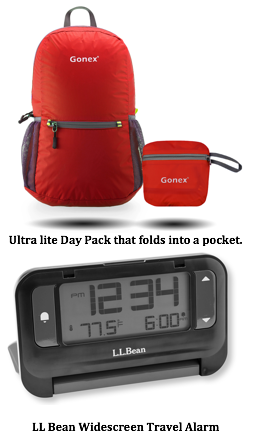 Devices:
Basics; Internet; Chargers; Camera
Devices:
Basics; Internet; Chargers; Camera
Basics: An umbrella, day pack, travel alarm and compass are the most important devices. None are overtly electronic. I didn’t mention cell phone because we don’t use one. We may have one tucked away to call someone to pick us up when we get home, but that is it.
Internet: We take a device for Wi-Fi email and browsing. This is our preferred way of communicating with people back home, and it works well no matter what time zone we are in. We must always remember that Wi-Fi is not as prevalent abroad as it is back home. You can almost always count on the lobbies of better hotels for free Wi-Fi. Other than that, you have to be flexible and wait until you find Wi-Fi access. I prefer an iPad. For people that text while traveling in different time zones, they must be aware that the person that they are emailing may be sleeping. Chargers: Make sure all chargers are for 110-220v, 50/60 Hz. This avoids the hassle of having voltage converters, which are heavy transformers. I always take an extension cord. It means that I only need one plug adapter and permits me to plug multiple chargers in at one time. It also solves the problem when the outlet is not where you want to place your chargers.
Camera: I take a camera with a rechargeable battery and spare batteries. Many people just use the camera on their cell phone. My camera is a digital “super-zoom” meaning it has a zoom lens that goes from wide angle to long telephoto. It also is very sensitive and can take pictures in most lighting conditions without flash. It has a flash to use for filling in harsh shadows when photographing in direct sunlight. It has over four-times as many pixels as I really need, but they are useful for extra resolution when photographing large groups and I want to see everyone’s face, or when using digital zoom to shoot something further away than what the optical zoom of the lens will reach. In doing so much telephoto zoom photography, it is necessary to have image stabilization built into the camera to avoid any blur, especially under lower light conditions or with a moving object. The lens is not removable, allowing the camera to be moisture and dust proof. I take a camera bag that will hold my camera, spare batteries and memory cards, my sunglasses, and a small umbrella. Photography is a primary goal when I travel. I want to get lots of good pictures to use for programs at churches, camera clubs, garden clubs, and service clubs. I take a lot of flower close-ups. For these, the zoom and fill flash are super important. Two things will ruin a flower picture. The first is not being able to zoom in on a single bloom. The second is having to take a picture in full sun without fill flash to remove the harsh shadows. I often take two photos, one with fill flash and one without fill flash. Then, when I am editing my photos, I select the best one. I try to avoid getting too many photos with people in them since I create programs about what we visited, not who we visited or where stayed. But I always try to take some photos that will be good on our Christmas letter. In very popular places where there are lots of people, I don’t worry about the people in the picture since that is part of being there. I love to go over to wedding parties and ask if I can take wedding pictures along with everyone else. These are great to add to travel programs. I am not into taking photos of hotels or meals unless they are truly special and different. 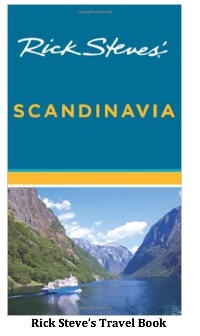 Route: Travel Books; Maps; GPS; Local Events
Route: Travel Books; Maps; GPS; Local Events
Travel Books: Most travel books are good. We always pick one that is light. Some have beautiful pictures but seem like they weigh a ton. Most hotel lobbies have brochures with walking maps of the city and directories of shops and restaurants. We always have a map with us, either one from a brochure or one provided by our hotel. Also, we carry a card or other ID for our hotel to help us find our way back. If we don’t speak the language, we ask the hotel to write down directions to give a taxi driver to get us to our destination and also back to our hotel. We ask locals about where we can find good restaurants. I like travel books like Frommer’s and Rick Steve’s that prioritize the more important sights. Any guide book can list off dozens of attractions, but the better guide books can point out the best attractions and sights and why they are better. Maps: When traveling by car, road maps are important, even if you have a GPS. We have a store in King of Prussia, PA, called Franklin Maps that has road maps of just about every place in the world. Even if we are not driving we like maps of the area so we can follow along while we are traveling. When exploring a city it is important to have a city map. AAA carries some inexpensive popup maps of major cities. The maps in tourist brochures in hotel lobbies are good also.
A much more compact solution is to use your smart phone as your GPS. Sygic has apps for most smart phones that make your smart phone into a GPS but don't need live data. You download map data for every state or country you are going to visit before you leave home or whereever Wi-Fi is available and you have free maps. Then the data resides on your smart phone and no data service is necessary. This is espeially handy when traveling abroad where it is difficult to find a GPS that will have foreign map an US maps. The app with lifetime world maps starts around $25. Cell Phone Service: Some cell phone providers have a plan that is economical to use when traveling abroad where roaming charges can be horrendous. There are horror stories for people leaving their data on and paying thousands of dollars. However, since I use Wi-Fi at my hotels for data, I bought a SIM Card from Mobal for $15 that allows me to make calls and use text to and from 190 countries and has no monthly fees. I only pay when I use it. Then it charges my credit card between $1 and $2 per minute. So it is not for long casual calls, but is great for touching base occassionally. Much cheaper than paying a monthly rate. That's it, one Sim Card and nearly the whole world is accessable from anywhere. If you are only gone for a couple days, you don't have to pay for a month where you many not even make any calls. When traveling by air, keep you phone handy so when you land you can call for someone to pick you up at the airport.
Local Events, Concerts and Plays: One thing that is special is to time our trip to catch a local festival, or to attend a concert. We like to see if we can attend a classical music concert, not always just for the music, but also for the venue such as the Concertgebouw in Amsterdam, the Sidney Opera House, London’s Royal Albert Hall, and the Santa Fe Opera. The London theater districts are great places to see plays, many at much less than the ticket prices on Broadway and, best of all, we don’t have to wait months to get tickets. In fact at Leicester Square in London they have ticket sales for plays on the same day at greatly discounted prices. We saw Mamma Mia in English in Hong Kong put on by an Australian theater company. We also saw a children’s recital of Chinese Opera in Hong Kong. A Chinese couple that spoke English saw us and came over to ask why we were there since most people attending were family members of the children that were performing. When they found out we were curious about Chinese Opera and enjoyed watching the children, they sat next to us and told us the story behind what the children were doing. Food & Lodging: Food; Hotels; Tipping
Food: Some people have trouble adapting to food or water in different areas. Always drink bottled water unless you are sure of the local tap water. Even some tap water in the US is not potable. Some potable tap water may cause unpleasant symptoms if your system can't adapt to differences. When in doubt, only eat foods that are cooked or peeled. One sage saying is to “only eat seafood if you can see the ocean.” In some countries, all meat and seafood is freshly slaughtered since there is very little refrigeration. One advantage of group tours is that they usually only go to places that have food and water that is safe. Never buy food from sidewalk vendors that don’t have places to wash their hands. Their food may look great, but it may not have been refrigerated for a long time and the attendant may not be able to wash his hands. The locals’ systems have adapted to things that we can’t tolerate. If you have food allergies or restrictions, make sure your tour guide is aware of them. If you are traveling independently, carry a list of what you are allergic to written in the local language. You may want to pack some backup foods that are dehydrated and compact such as decaf coffee or tea, and artificial sweetener. Be aware that even places that use English may use British English for foods such as aubergine for egg plant; biscuit for cookie; coriander for cilantro; courgette for zucchini; crisps for potato chips; digestive biscuit for graham cracker; doner kebob for gyro; gammon for ham; mange tout for snow peas; paw paw for papaya; prawn for shrimp; profiterole for cream puff; scone for biscuit; sultanas for raisins, and tart for pie. Also remember, table napkins are called serviettes in British English.
Hotels: It is always easiest to stay in large “American style” hotels such as Hiltons, etc. But our most memorable experiences are when we stay at smaller boutique hotels. We always check in guide books for a highly recommended local hotel. We get much more personal service and learn more about local customs. Usually someone at the front desk can speak English and help us plan our daily itinerary. They will even write out our itinerary so that a taxi driver knows where to take us and how to bring us back to our hotel. Tipping: We always make sure our guide book has a section on local tipping expectations. If it doesn’t, we look up online to see what the local customs are. It is always appropriate to tip someone who provides us special service. In some places tipping is not expected. In other places, a service charge is included in our bill. In many places we are expected to always round the amount owed up to an even number; “keep the change.” Safety: Advisories; Cards; Spare Wallet; ATMs; Documents
Be Prepared: We always check the State Department’s website for travel advisories. This is even important when traveling back to a place where we feel comfortable. Things may have changed. In most destinations, the biggest threat is pick pockets. Men should carry their wallets in a front pocket with a rubber band around it so it won’t easily slide out of their pocket. Women are advised to use “fanny packs” rather than purses. These “fanny packs” are small and are worn with the pack in front. Even with my wallet in my front pocket and a camera bag hanging over the pocket, I was pickpocketed. Thankfully, I had a spare wallet in my suitcase with a different set of credit and debit cards and photocopies of my IDs. We cancelled the lost cards and were able to finish our trip. My passport was in a different pocket and was safe.
Cards: If traveling anywhere outside the US, we only take cards with chips. Most other countries only accept cards with chips. When choosing which credit cards and debit cards, we choose ones with the lowest foreign transaction fee. Always read the fine print and see what the fees are. At airports we need our credit cards or passports to get our boarding passes. ATMs: When getting cash in foreign countries, the best exchange rates are at bank ATM machines. I say bank ATMs because they are the most reputable and less likely to have high fees or skimming devices. But it is best to purchase items with credit cards if possible. They get an even better exchange rate. They also provide additional consumer protection. Cash is good for small items and vendors that can’t take cards. We use up our foreign currency when checking out of our last hotel in a country. The currency exchange fees add up, so we avoid exchanging currency. Travel Documents: We always carry two forms of identification: typically our passport and driver’s license. We make sure we check to see if we need a visa. We also check to see if we should have any special vaccinations. We keep a record of all of our vaccinations. Our local hospital in Reading, PA, has a travel medicine department that helps us with this and knows which vaccinations we already have and which we will need. We always take a list of all of the email addresses for our family, friends and financial advisors. We had to pay a hospital bill before we were allowed to leave Chile and the hospital didn’t know how to charge our credit cards. He had to have a bank person in the US that spoke Spanish talk them through charging our account. We always have spare copies of our reservations and the booking numbers stored in two different bags. Important Details: Trip Insurance; Travel Agents; Shopping; Respect
Trip Insurance: Trip insurance has two important coverages. First, medical coverage is important, especially if your own insurance will not cover you. Even if your own insurance covers you, you may want additional coverage such as emergency evacuation to a home hospital. We had an accident in Chile that required hospitalization and surgery. We elected to have it done in a Chilean Navy hospital in Punta Arenas, Chile, since the medical facilities were excellent and the surgeon had trained in Virginia. Our travel agent helped us submit the entire bill to our travel insurance, but before they would pay it they asked we submit it to our insurance. Our insurance paid the entire bill since it was “emergency treatment.” They don’t normally pay for treatment outside the US. Second, trip coverage often covers losses of baggage and trip cancellation by either you or the tour company. It usually covers trip interruption by illness or injury, terrorist threats, or emergency travel home. We had a 4-week trip to Africa interrupted by a death in the family while we were in Amsterdam, en route to Africa. The trip insurance kept us from losing all of our money, and we were able to rebook the same trip a year later. Trip insurance is best booked with a travel agent since it is usually least expensive if booked at the time reservations are made. I feel trip insurance is a part of the cost of travel. The trip cancelation insurance is important if you don’t want to risk loosing the cost of your trip due to something beyond your control.
We have a travel agent, Kathy at KoKo Travel, that excels at arranging independent travel. She has access to many low price options that are not advertised to the public. For example, if we are tired of being packed in a plane like a sardine, our travel agent finds roomier options such as premium tourist class or budget business class. Our travel agent can book tours that are not available online and connect multiple tours from different companies together. Our travel agent booked our Africa trip with a tour in South Africa followed by a tour in Zambia and Tanzania. The policy of the company she booked with was to run the tour if 2 or more people signed up. We were the only people who signed up so we had a private tour with our own driver and guide, or driver-guide. It was very personal and very flexible. Recently our travel agent booked a private tour of Easter Island and then connected that with a Tauck Expedition to Antarctica already en route. This would have been very difficult without a travel agent. It saved a bundle on redundant airfares.
Shopping is seldom a prime concern for our travel. I do like to do birthday and Christmas gift shopping while on trips if possible so that I have something special. We do not try to buy something for everyone. Our gift is to bring back pictures to show our friends. I do like to make sure my wife has souvenirs of places where we travel, usually a piece of jewelry, since jewelry is small and doesn’t take up much space, which she keeps reminding me. I like hand carved wood objects such as a boomerang or carved animals & birds. They are light weight and easy to carry. When I was in India, I found 3 larger items, a folding chair, a camel saddle, and a silk carpet. Since I was with a reputable tour and the tour guide worked with me to arrange home shipment, I went ahead and got them. They arrived in excellent condition. The folding chair and camel saddle were packed in hand made aluminum trunks. You can’t always trust merchants unless they can be held accountable. Respect: Be respectful of the countries you visit, your fellow travelers and your guides You may have heard of the “ugly American.” We have seen them and try not to be one.
Most luxury hotels have tissues and common toiletries in case you forget something. However, many countries don’t have the products you are accustomed to, so be sure to take ample amounts. I always make sure my deodorant is new, by taking the used one from my travel bag when I need a replacement at home, and putting the new one in my travel bag. I carry a couple small, travel sized toothpaste tubes and a spare comb. For a safer shower I always have lightweight cloth-free shower shoes that are easy to dry. We take small travel sizes of any bulky items. We always take tissues with us in case we must use a toilet with no paper. We also take extra tissues in our suitcase. We can replenish our supply at any hotels that supply tissues. We keep our toiletries together in a pouch. Besides our own personal medications, we have some travel medicines such as:
Our Travel Map: courtesy of Trip Advisor
You are invited to visit the Henning's other websites. Last Updated: May 17, 2020 |